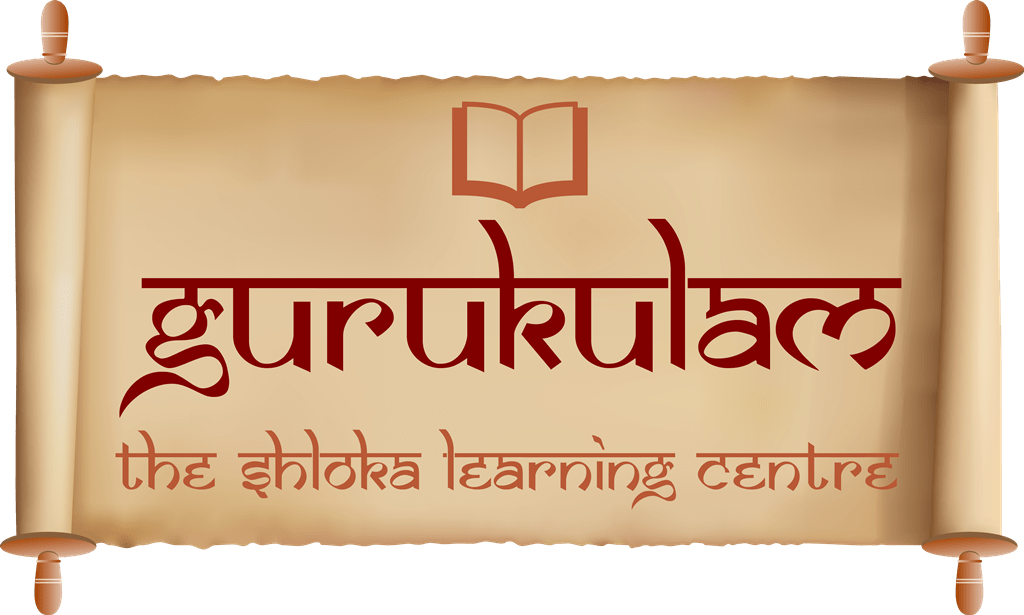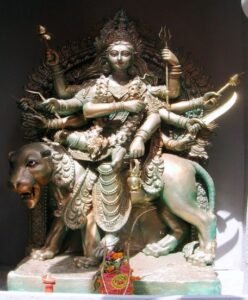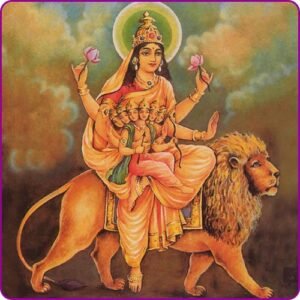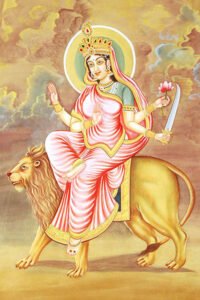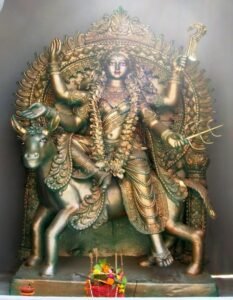Goddess Shailaputri is the 1st Navadurga worshipped during the 1st Day of Navratri. She is the daughter of The Mountain King – Himavat and the Manifestation of Mother Goddess Mahadevi.
Shailaputri is derived from the words: Shaila = Mountain and Putri = Daughter. Also called Sati Bhavani, Parvati or Hemavati – The Daughter of Parvat Raj Himalayas (The King of The Himalayas). She is the embodiment of Lord Brahma, Lord Vishnu and Lord Shiva.
How does Goddess Shailaputri Look?
Goddess Shailaputri is depicted with 2 hands and has a cresent moon on her forehead. She hold a trident in her right hand and a lotus in her left hand and rides on The Mount -Nandi, The Bull.
In The Shiva and Devi Bhagavata Purana —-
The Story of The Mother Goddess says – Maa Bhagavathi in her earlier birth was born as a daughter of Prajapati Daksha. Her name then was Sati and she was married to Lord Shiva. In a sacrificial ceremony organised by her father Prajapati Daksha, her body was buried in the yogic fire because she could not bear the insult of her husband Lord Shiva by her father Prajapati Daksha in the sacrificial ceremony.
In the next birth, She was born as Goddess Parvati – The daughter of Parvat Raj Himalaya (The King of The Himalayas), the wife of Lord Shiva and The Mother of Lord Ganesha and Lord Muruga and the embodiment of patience and the starting point of spiritual discipline.
The Upanishads say Goddess Shailaputri reduced the egotism of Indra and Other Devtas. Ashamed they bowed down and prayed that -“In fact though are Shakti. We all -Brahma, Vishnu and Shiva are capable of getting Shakti from you” . Goddess Shailaputri is the essence of earthly excistence and her abode is in the Muladhara Chakra.
Article by – Divyaa Doraiswamy
Goddess Brahmacharini called the mightiest of NavaDurgas is the epitome of knowledge and wisdom and personifies love and loyalty. She is worshipped on the 2nd day of Navratri and is the 2nd aspect of The NavaDurga forms of Mahadevi.
Maa Durga’s manifestation as the one who does penance or tapasya to Lord Shiva translates as Brahmacharini Maa. She is also called Devi Yogini and Devi Tapasvini.
How does Goddess Brahmacharini look?
Goddess Brahmacharini is a very important aspect of Goddess Parvati.
She wears white clothes holding a JapaMala in her right hand and a Kamandalu (Water Pot) in her left.
Legend has it that Goddess Brahmacharini is very majestic and illuminant.
As advised by sage Narada she went into deep tapasya (penance) for 1000’s of years to attain Lord Shiva as her consort. She completely stayed away from food and water and consumed only BILVA LEAVES for survival. She was extremely devoted to Lord Shiva and due to her tapasyas this unmarried form of Parvati came be called Brahmacharini Maa. Lord Shiva was so pleased that he eventually married her.
Article by – Divyaa Doraiswamy
Worshipped on the 3rd Day of Navratri, Goddess Chandraghanta is the 3rd Navadurga aspect of Goddess Mahadevi. She is believed to grant eternal power and strength to her devotees.
How does Goddess Chandraghanta look?
The Body of Goddess Chandraghanta is golden in color. She rides on a lion that represents “Dharma”.
Goddess Chandraghanta has ten hands and three eyes. In her ten hands she holds weapons like trident, mace, spear, bow, arrow, discus and sword. In the others she is holding a lotus, a sacred pot and a bell. One of her hands is in the blessing mudra. On her forehead is a crescent moon that looks like a bell in a temple and therefore her name Chandraghanta – One who has a moon in the form of a bell. Her third eye situated in the middle of her forehead is always open.
Legend has it that Goddess Parvati had done severe penance to attain Lord Shiva as her husband. At this time Lord Shiva had lost his first wife Sati and had gone to the mountains to mourn her.
Eventually Lord Shiva was pleased with Goddess Parvati’s devotion and agreed to marry her. In fact Goddess Parvati was Sati reincarnated.
When Lord Shiva visited Goddess Parvati’s home his form was rather frightening. He had ash smeared all over his body, had matted hair and wore a garland full of skulls and snakes around his neck.
To protect her family , Goddess Parvati took an equally frightening form of Goddess Chandraghanta to persuade Lord Shiva to appear in a more appealing form. Lord Shiva agreed and appeared as a prince bedecked with jewels. Now happy with this form of Lord Shiva, Goddess Parvati married Lord Shiva in a grand ceremony which is celebrated as MahaShivaratri every year.
Article by – Divyaa Doraiswamy
Goddess Kushmanda is worshipped on the 4th day of Navratri. The Creator of The Universe that she is, The Kalikula Sect of Shaktism believe her to be the 4th aspect in the Navadurga forms of Mahadevi. She is known to be the bestower of health, wealth and strength and her abode is in the Anahata Chakra (Heart Chakra).
The name Kushmanda is derived from —
Ku = A little; Ushma = Warmth or Energy and Anda =Cosmic Egg
According to Hindu Mythology it is believed that Maa Kushmanda created the universe by producing a small cosmic egg from which the universe emerged. She is called Astabhuja Devi as she is depicted with 8 hands holding a trident, a discus, a sword, a hook, a mace, bow, arrow and two jars of Amrut (Elixir) and blood. She rides on a lioness and one of her hand is always in Abhayamudra Pose from which she blesses all her devotees.
The Hindu Mythology further says that Lord Vishnu was able to start creating the universe when Goddess Kushmanda smiled like a flower which blossomed with a bud.
Goddess Kushmanda created the world from nothing at a time when there was eternal darkness all around. Besides being called the creator of the universe she is also called Adiswarup and Adishakti. Furthermore it is believed that she lives in The Core of The Sun and is the one who provides direction to Surya – The Sun God.
After creating The Universe – Goddess Kushmanda created 3 Supreme Goddesses:
~ With her LEFT EYE she created a terrorizing form and named her MAHAKALI.
~ From the CENTRAL EYE (on her forehead) she created another a ferocious form and named her MAHALAKSHMI.
~ From her RIGHT EYE came an extremely benevolent and smiling form which she named MAHASARASWATHI.
Goddess Kushmanda then offered Goddess Parvati to Lord Shiva, Goddess Saraswathi to Lord Brahma and Goddess Lakshmi to Lord Vishnu as their respective consorts and finally absorbed herself and then entered Shakti as an object of divine, powerful and unending energy.
Article by – Divyaa Doraiswamy
The 5th day of Navratri is dedicated to Goddess Skandamata – The 5th manifestation of Goddess Durga. Since she is the mother of Skanda (Subramanya/Karthikeya/Muruga) she is called Skandamata
How does Goddess Skandamata look?
Goddess Skandamata is portrayed as holding Lord Skanda in his infant form through her left hand and a lotus in her right hand. She has 4 arms, 3 eyes and a bright complexion. She is many times called Padamasani since she is seated on a lotus flower. The left arm of the Goddess is in a pose to grant boons with grace to her devotees.
Legend has it that The Demon – Tarakasura once pleased Lord Brahma with great penance and devotion. He asked Lord Brahma to make him immortal. Lord Brahma immediately denied and said no one can escape death. Considering himself to be very smart, this demon- Tarakasura thought that Lord Shiva would never marry and asked Lord Brahma for a boon that no one except the son of Lord Shiva can kill him.
Meanwhile Tarakasura started troubling the people on earth. Fearing his strength would cause a lot of destruction, the devatas requested Lord Shiva to get married.
Lord Shiva then married Goddess Parvati and then their child Skanda Kumar brought an end to Tarakasura and Skanda also became the Commander-in-chief of the Devatas in the war against demons.
Praying to Goddess Skandamata is believed to grant her devotees with Salvation, Power, Prosperity and Treasures.
Article by – Divyaa Doraiswamy
Hindu Scriptures say that Goddess Katyayani was born in the home of Sage-Katya and hence her name came into being.
Goddess Katyayani is worshipped on the 6th Day of Navratri. Believed to be the destroyer of evil, Goddess Katyayani is seen as the Warrior Goddess who was able to bring peace to the world. She is often seen as The Slayer of The Demon Mahishasura and hence called Mahishasura Mardini.
Goddess Katyayani is depicted having 4 hands that carry a lotus and a sword on the left hand with The Abhaya and Varada Mudra on the right hand. She rides on a lotus. In Shaktism she is associated with the fierce form of Shakti or Durga – The Warrior Goddess which includes Badrakali and Chandrika and traditionally associated with the color RED.
The Vamana Purana says Goddess Katyayani was created from the combined energies of The Gods when their anger at the Demon – Mahishasura manifested itself in the form of energy rays. The rays crystallised in the hermitage of Rishi Katyayana who gave it proper form and therefore she is called Katyayani (The Daughter of Katyayana).
However in the Kalika Purana it is mentioned that it was Rishi Katyayana who first worshipped her and hence she came to be known as Katyayani. In either case she is the demonstration of Goddess Durga and hence worshipped on the 6th Day of Navratri.
The Bhagavad Purana describes the legend of The Katyayani Vrata where young marriageable daughters (Gopis) of The Cowherd Men of Gokula in Braja worshipped Goddess Katyayani and took a Vow (Vrata) during the entire month of Marghashirsha to get Lord Krishna as their husbands.
Article by – Divyaa Doraiswamy
One of the fearsome forms of Goddess Durga is Kalaratri.
The 7th day of Navratri is dedicated to Goddess Kaalaratri – her very appearance invoking fear. This form of Goddess Durga is believed to be the destroyer of all demon entities – ghosts, spirits and negative energies who flee upon knowing of her arrival.
Mahamaya, Mahakali , Trisha, Trishna and Nidra are her other names.
KALARATRI means the one who is the “Death of Kaal” – Kaal here is referred to as death and Ratri is Night.
Therefore Kalaratri is the one who destroys ignorance and removes darkness , thereby depicting that life also has a dark side – The Violent Mother Nature who nurtures life can also create havoc and remove all dirt.
How does Goddess Kalaratri Look?
Goddess Kalaratri is of the dark night complexion which is BLACK. Her thorny necklace shines like the lights from thunder. Her 3 eyes emanate rays like lightening.
She is clad in a loose red cloth to cover her upper body and wears tiger skin below her waist. Her whole body has thorny garlands, anklets ,waist bands , wrist bands and armlets. Her hair is bountiful but dishelved. She has 4 hands. The left handcarries the cleaver and torch and the right hand is in Varada Mudra and Abhaya Mudra.
Her Vahana is The Donkey.
Mythology: In her fight with demons she is called Shubhankari.
In this form she killed The Demon – Raktabeeja. Raktabeeja could multiply from every drop of his blood which fell on the ground. This Goddess Kalaratri killed him by licking the blood before it could reach the ground and hence conquered him.
Devotees need not fear her as she basically symbolises auspiciousness – the main aim of this avatar is to protect the devotees from troubles.
Article by – Divyaa Doraiswamy
The most beautiful and radiant form of Goddess Parvati is Goddess Mahagauri worshipped on the 8th day of Navratri.
Hindu Mythology says that Goddess Shailaputri was extremely beautiful and blessed with a fair complexion at the age of 16 and hence came to be called Mahagauri because of her fair skin.
Like Maa Shailaputri she mounts a bull and because of that she is called Vrisharudha. She has 4 hands – while one hand on the right carries a Trishul and the other hand stays in Abhaya Mudra, she holds a damaru in one left hand and keeps the other hand in Varada Mudra. Goddess Mahagauri is often compared with A Conch, The Moon and Jasmine Flowers because of her fair complexion. Goddess Mahagauri is also called Shwetambaradhara since she wears white clothes symbolising purity, serenity and tranquillity.
Legend has it that Demons Shumbha and Nishumbha could only be killed by a virgin. Lord Brahma repeatedly called Goddess Parvati – “ Kali ” for no reason in a mocking way. Goddess Parvati was very hurt by this teasing, so she performed severe penance to please Lord Brahma and requested him to grant her a golden complexion. Lord Brahma explained his inability to do so and instead requested her to slay the Demons Shumbha and Nishumbha – the two powerful demons who had defeated The Gods and were creating havoc. Goddess Mahagauri agreed to kill these demons.
Meanwhile Shumbha and Nishumbha hearing of her beauty proposed to marry Goddess Mahagauri. Goddess Mahagauri not only refused their proposal but challenged them to battle. The battle went on for days with no one gaining upper hand. Finally Goddess Mahagauri transformed into Goddess Kali and defeated Shumbha and Nishumbha thereby killing them with her Trident.
Praying to Goddess Mahagauri on the 8th day of Navratri helps devotees overcome fears and obstacles and attain victory over enemies.
Article by – Divyaa Doraiswamy
Goddess Siddhidatri is the 9th aspect and final among the Navadurga aspects of The Hindu Mother Goddess – Mahadevi.
The name Siddhidatri is derived from the words “Siddhi” meaning Supernatural Powers and “Dhatri” meaning Giver.
Goddess Siddhidatri sits on a lotus and rides a lion. She has 4 arms – In her right hand she holds A Mace and Sudarshana Chakra and in her left hand she holds A Lotus and A Shankha. She is surrounded by Gandharvas, Yakshas, Siddhas and Asuras who worship her.
Hindu Mythology says that when the Universe began, Lord Rudra worshipped Goddess Adi-Parashakti, The Supreme Goddess of Power. Since she had no form she appeared in the form of Goddess Siddhidatri from the left half of Lord Shiva. When this happened Lord Shiva came to be called Ardha-Narishwara (The half female and half males forms of Lord Shiva). The Scriptures further say that Lord Shiva attained all the Siddhis (Supernatural Powers) by worshipping this Goddess.
Devotees worship Goddess Siddhidatri on MahaNavami and its a belief that she takes away ignorance from devotees and grants them knowledge and bestows them with accomplishments
Article by – Divyaa Doraiswamy
